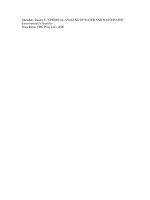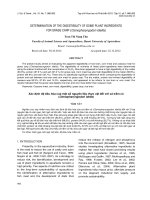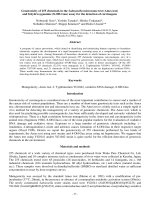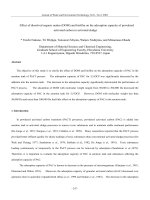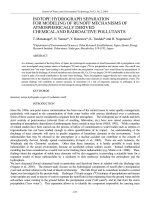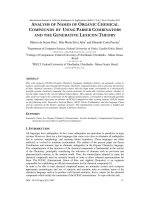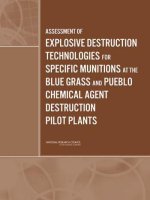Separation and determination of the physico chemical
Bạn đang xem bản rút gọn của tài liệu. Xem và tải ngay bản đầy đủ của tài liệu tại đây (238.52 KB, 6 trang )
Separation and determination of the physico-chemical
characteristics of curcumin, demethoxycurcumin and
bisdemethoxycurcumin
L. Pe
´
ret-Almeida
a,b
, A.P.F. Cherubino
b
, R.J. Alves
c
, L. Dufosse
´
d
, M.B.A. Glo
´
ria
b,
*
a
Departamento de Engenharia Agricola e Solos, Universidade Estadual do Sudoeste da Bahia, Vito
´
ria da Conquista, BA, Brazil
b
Departamento de Alimentos, Universidade Federal de Minas Gerais, Av. Antonio Carlos, 6627, 31270-901 Belo Horizonte, MG, Brazil
c
Departamento de Produtos Farmace
ˆ
uticos, Faculdade de Farma
´
cia, Universidade Federal de Minas Gerais, Av. Antonio Carlos, 6627,
31270-901, Belo Horizonte, MG, Brazil
d
Laboratoire ANTiOX, Universite
´
de Bretagne Occidentale, IUP Innovation en Industries Alimentaires, Po
ˆ
le Technologique de CreacÕh Gwen, F-29018
Quimper cedex, France
Received 6 June 2004; accepted 15 February 2005
Abstract
The objective of this work was to separate and determine the physico-chemical and color characteristics of isolated curcuminoid
pigments. Thin-layer chromatographic separation of curcuminoid pigments was possible on silica gel 60G plates using dichloro-
methane:methanol, 99:1. The preparative separation of curcuminoid pigments was accomplished by crystallization of curcumin
in methanol:water and further separation by column chromatography using silica gel 60G impregnated with sodium hydrogen phos-
phate and dichloromethane as the eluent. The purity of each curcuminoid pigment was confirmed by high performance liquid chro-
matography and determination of the melting point. The isolated pigments were characterized with respect to ultraviolet, visible,
infrared, nuclear magnetic resonance and color characteristics. The molar absorptivity of each pigment was determined. This data
can be used for the identification and quantification of individual curcuminoid pigments.
Ó 2005 Elsevier Ltd. All rights reserved.
Keywords: Curcumin; Curcuminoid pigments; Color; NMR; Infrared; TLC
1. Introduction
The rhizomes of turmeric (Curcuma longa L.), a plant
of the Zingiberaceae family, provide a yellow and flavor-
ful powder when dried and ground. Recently, it has been
valued worldwide as a functional food because of its
health promoting properties (Ammon & Wahl, 1991;
Jayaprakasha, Rao, Mohan, & Sakariah, 2002). There
are several reports in the literature indicating a variety
of pharmacological activities of turmeric, such as antin-
flammatory, anti-human immunodeficiency virus, anti-
microbial, antioxidant, antiparasitic, antimutagenic
and anticancer (Ahsan, Parveen, Khan, & Hadi, 1999;
Kim, Park, & Kim, 2001; Mesa, Ramirez-Tortosa,
Aguilera, Ramirez-Bosca, & Gil, 2000; Reddy & Chand-
rakasan, 1989; Simon et al., 1998). It is also efficient in
the treatment of circulatory problems, liver diseases,
and dermatological disorders (Osawa, Sugiyama, Inayo-
shi, & Kawakishi, 1995; Semwal, Sharma, & Arya, 1997;
Srinivasan, Sambaiah, & Chandrasekhara, 1992; Toda,
Miyase, Arichi, Tanizawa, & Takino, 1985).
The pharmacological activities of turm eric ha ve
been attributed to its ethanol extracts, which contain
0963-9969/$ - see front matter Ó 2005 Elsevier Ltd. All rights reserved.
doi:10.1016/j.foodres.2005.02.021
*
Corresponding author. Tel.: +55 31 34996911; fax: +55 31
34996989.
E-mail address: (M.B.A. Glo
´
ria).
www.elsevier.com/locate/foodres
Food Research International 38 (2005) 1039–1044
three different curcuminoid pigments (Fig. 1), curcumin
(C) [1,7-bis(4-hydroxy-3-methoxyphenyl)-1,6-heptadiene-
3,5-dione], demethoxycurcumin (DMC) [1-(4-hydroxy-
phenyl)-7-(4-hydroxy-3-methoxyphenyl)-1,6-heptadiene-
3,5-dione] and bisdemethoxycurcumin (BDMC) [1,7-
bis(4-hydroxyphenyl)-1,6-heptadiene-3,5-dione] (Bong,
2000; Jayaprakasha et al., 2002).
A variety of methods have been reported for the
quantification of curcuminoid pigments. Most of them
are spectrophotometric, expressing the total color con-
tent of the sample (ASTA, 1985). Commercially avail-
able curcumin consists of a mixture of naturally
occurring curcuminoids with curcumin as the main con-
stituent (Ahsan et al., 1999; Jayaprakasha et al., 2002).
Since the curcuminoid pigments vary in chemical struc-
tures, it is possible that the chemical and color charac-
teristics, as well as the functional properties, will vary
among the pigments. Pure C is scarce and expensive,
whereas DMC and BDMC are not commercially avail-
able. Therefore it is important to obtain pure pigments
and to characterize them individually to provide subsi-
dies for the determination of each curcuminoid pigment.
Several studies wer e undertaken to separate curcumi-
noid pigments by thin-layer chromatography (TLC) and
column chromatography (CC). The stationary phase
most used was silica gel 60G with different solvent systems
including benzene, ethyl acetate, ethanol, chloroform,
acetic acid, hexane and methanol for TLC (Govindara-
jan, 1980; Janaki & Bose, 1967; Janben & Gole, 1984;
Krishnamurthy et al., 1976; Osawa et al., 1995) and
benzene, water, toluene and ethyl acetate for CC
(Srinivasan et al., 1992). However, poor resolution and
curcumin bands with only up to 80% purity were
obtained. Furthermore, no separation was obtained for
demethoxycurcumin and bisdemethoxycurcumin.
This study was undertaken to provide information on
the physico-chemical characteristics of individual curc-
uminoid pigments to facilitate their identification in
the mixture. The specific objectives were to (i) compare
TLC methods for the separation of curcuminoid pig-
ments; (ii) develop methodology for the preparative sep-
aration of cu rcuminoid pigments; (iii) determine the
physico-chemical and color characteristics of the indi-
vidual curcuminoid pigments.
2. Materials and methods
2.1. Materials
A mixture of curcuminoid pigments from turmeric
was obtained from Merck (Darmstadt, Germany). The
chemicals used were of reagent grade, whereas HPLC
solvents were chromatographic grade.
2.2. Methods
2.2.1. Comparison of TLC methods for the separa tion of
curcuminoid pigments
The analytical separation of curcuminoid pigments
by TLC was investigated using silica gel 60G (Merck,
Darmstadt, Germany) plates (4.5 · 10 mm) developed
with different solvent systems as indicated in Table 1.
The method was selected according to the R
f
values
for each pigment.
2.2.2. Preparative separation of curcuminoid pigments
Crystallization of curcumin. Crystallization of curcu-
min was performed by dissolving a 500 mg sample in
50 mL of methanol at 60 °C. After dissolution, 10–
12 mL of distilled water was added, and the mixture
was kept at 5 °C for 2 h. The curcumin crystals were sep-
arated from the mother liquor by filtration.
CC separation of the pigments from the mother liquor.
The mother liquors from the crystallization were com-
bined and dried at 60 °C on a rotary evaporator (Bu
¨
chi,
Switzerland). A 100 mg portion of the dried powder was
dissolved in acetone, mixed with silica gel (0.01 g) and
subjected to CC on a 85 · 1.3 cm glass column packed
with 20 cm Silica gel 60G (Merck, Darmstadt,
Germany), 0.063–0.200 mesh (Rasmussen, Christensen,
Kvist, & Karazmi, 2000). The silica was impregnated
with sodium hydrogen phosphate (NaH
2
PO
4
) and the
eluent was dichloromethane. The fractions collected
Table 1
Efficiency of different solvent systems on the separation of curcuminoid
pigments by TLC
TLC mobile phases R
f
a
C DMC BDMC
Toluene:ethyl acetate (97:3) 0.90 0.86 0.80
Toluene:ethyl acetate (90:10) 0.84 0.80 0.75
Chloroform:methanol (95:5) 0.40 0.34 0.25
Dichloromethane:methanol (99:1) 0.47 0.28 0.16
Dichloromethane:methanol (95:5) 0.53 0.42 0.33
a
C, curcumin; DMC, demethoxycurcumin; BDMC, bisdemethoxy-
curcumin.
C
C
O
H
C
C
R1
HO
C
C
C
O
R2
OH
1
2
3
4
5
6
7
8
9
10
2'
3'
4'
5'
6'
7'
8'
9'
10'
Compound R1 R2
Curcumin OMe OMe
Demethoxycurcumin H OMe
Bisdemethoxycurcumin H H
Fig. 1. The chemical structures of the curcuminoid pigments.
1040 L. Pe
´
ret-Almeida et al. / Food Research International 38 (2005) 1039–1044
were grouped according to their TLC profile, concen-
trated under vacuum at 40 °C and analyzed by HPLC.
2.2.3. Physico-chemical characterization of the separated
curcuminoid pigments
The separated pigments were analyzed for curcumi-
noid pigments by HPLC, melting point, UV–vis spectro-
photometry, infrared spectroscopy, nuclear magnetic
resonance, and CIE L*, a*, b* characteristics.
2.3. Methods of analysis
2.3.1. Determination of curcum inoid pigments by HPLC
The pigments were dissolved in ethanol and filtered
through 0.45 lm, 13 mm HVLP membranes (Millipore
Corp., Milford, MA, USA), separated by HPLC and
quantified using a diode array detector at 425 nm
(Pe
´
ret-Almeida, 2000). A spherical Shim-pack CLC-
NH
2
column (5 lm, 4.6 · 150 mm, Shimadzu, Kyoto,
Japan) and a ethanol:water (85:15, v/v) mobile phase
with a flow rate of 1 mLmin
À1
at 22 ± 1 °C were used.
The concentration was calculated using the extinction
coefficient for each pigment.
2.3.2. Determination of the melting point
The melting point was determined using a melting
point apparatus MQAPF-301 Microquı
´
mica (Sa
˜
o Pau-
lo, SP, Brazil).
2.3.3. UV–vis spectrophotometry
Absorption spectra of the individual pigments in eth-
anol and ethanol:water (85:15, v/v) were determined on
a 106A spectrophotometer (Shimadzu, Kyoto, Japan).
Molar and specific absorptivity of each pigment were
determined using BeerÕs law.
2.3.4. Infrared spectroscopy
Each curcuminoid pigment (0.1 mg) was mixed with
100 mg KBr and pressed to form a pellet (Lee et al.,
2003) that was analyzed on an IR 400 Spectrophotome-
ter (Shimadzu, Kyoto, Japan).
2.3.5. Nuclear magnetic resonance
Spectra of
1
Hand
13
C were determined in DMSO-d
6
,
operating at 200 and 50 MHz, respectively, using a Bru-
ker AVANCE DPX200 NMR spectrometer (Rheinstet-
ten, Germany). TMS was used as an internal standard
(Jayaprakasha et al., 2002).
2.3.6. CIE L*, a*, b* characteristics
The CIE (Commission Internationale de lÕEclairage)
L*, a*, b* color characteristics of the individual pig-
ments (10 mg) incorporated with acetone in 10 g of silica
60G were determined using a ColorTec, PCM colorime-
ter (Accuracy Microsensor Inc., Pittsford, USA). Plain
silica was used to calibrate the equipment.
3. Results and discussion
3.1. Comparison of TLC methods for the separation of
curcuminoid pigments
TLC separation of curcuminoid pigments in silica gel
using different solvent systems resulted in the R
f
values
indicated in Table 1. All of the spots showed fluores-
cence under UV light. Some of the developing solvents
employed did not promote separation of DMC and
BDMC. The use of dichloromethane:methanol in the
proportion 99:1 provided the best results.
3.2. Preparative separation of curcuminoid pigments
3.2.1. Crystallization of curcumin
The first crystallization of the curcuminoid pigments
resulted in crystals containing 56.9% of curcumin and
other curcuminoid pigments (Table 2 ). Successive crys-
tallizations improved the purity of curcumin; however,
there was a loss in yield. In the third successive crystal-
lization, a 40% yield of 92% pure curcumin was obtained
with no BDMC detected. Further purification of the
crystals was possible by CC.
3.2.2. CC separation of pigments from the mother liquor
The compo sition of the fractions collected during CC
of the mother liquor is indicated in Table 3. Pure pig-
ments, determined by HPLC, were obtained in different
fractions, e.g., curcumin in fractions 1–14, DMC in 18–
30 and BDMC in 34–47. There was an average of 8.8%
loss of pigments on the column and an 8.0% loss because
Table 2
Influence of successive crystallizations on curcumin levels
Crystallization Crystals (mg) Curcumin (%)
a
Contaminants (%)
DMC BDMC
1st 294 56.9 30.1 13.0
2nd 214 72.8 19.5 7.7
3rd 193 92.2 7.8 –
a
Average of three experiments.
Table 3
Types of curcuminoid pigments in different fractions collected during
silica gel CC of the mother liquor using dichloromethane as the eluent
Fractions
a
Total volume (mL) Pigments present
b
Weight (mg)
1–14 1120 C 31.2
15–17 240 C, DMC 4.14
18–30 960 DMC 30.97
31–33 240 DMC, BDMC 3.88
34–47 1120 BDMC 21.06
a
Each fraction contains 80 mL.
b
C, curcumin; DMC, demethoxycurcumin; BDMC, bisdemethoxy-
curcumin.
L. Pe
´
ret-Almeida et al. / Food Research International 38 (2005) 1039–1044 1041
of the lack of separation of mixtures of pigme nts. How-
ever, the fractions that contained a mixture of the pig-
ments were concentrated and rechromatographed.
3.3. Purity of curcuminoid pigments
The purity of the curcuminoid pigments was demon-
strated by HPLC analysis and melting point determina-
tion. HPLC analysis of the isolated pigments showed
single peaks, as indicated in Fig. 2 with the retention times
as described in Table 4. The melting points are also indi-
cated in Table 4 . These values are similar to those reported
by Govindarajan (1980), but differ from those reported by
Jayaprakasha et al. (2002), that are higher.
3.4. Physico-chemical characteristics of the isolated
curcuminoid pigments
3.4.1. UV–vis spectra
Other physico-chemical characteristics of the isolated
curcuminoid pigments are also shown in Table 4. UV–
vis spectra indicated that the wavelengths of maximum
absorption in ethanol were 429, 424 and 419 nm for
C, DMC and BDMC, respectively (Fig. 3). Molar
absorptivity at 425 nm in ethanol was observed to vary
from 4.95 · 10
4
Lcm
À1
mol
À1
for BDMC to 6.73 · 10
4
Lcm
À1
mol
À1
for C, which correspond to specific
absorptivities A
1%
1
ÀÁ
of 1488, 1468 and 1445 gL
À1
for
the C, DMC and BDMC, respectively.
3.4.2. Infrared spectra
The infrared spectra are in conformity wi th the struc-
tures of C, DMC and BDMC. The absence of absorp-
tions bands in the aliphatic C–H stretching regions
(3000–2800 cm
À1
) corresponding to the methoxyl group
can be used to distinguish BDMC from C and DMC.
3.4.3.
1
H and
13
C NMR
A singlet corresponding to the two methoxyl groups
in curcumin was observed at d 3.92 in the
1
H NMR
spectrum. For DMC, the corresponding signal was ob-
served at d 3.82 (Table 5 and Fig. 1). The
13
C NMR sig-
nals for the methoxyl groups of curcumin and
demethoxycurcumi n occurred at d 55.7 (Table 6).
Fig. 2. HPLC analysis of the isolated curcuminoid pigments. HPLC conditions: spherical Shim-pack CLC-NH
2
column (5 lm, 4.6 · 150 mm,
Shimadzu, Kyoto, Japan), mobile phase of ethanol:water (85:15, v/v), flow rate of 1 mL min
À1
at 22 ± 1 °C, diode array detector at 425 nm: BDMC,
bisdemethoxycurcumin; DMC, demethoxycurcumin.
Table 4
Physico-chemical characteristics of the isolated curcuminoid pigments
Parameter Characteristics
a
C DMC BDMC
Melting point (°C) 184 172 222
HPLC, 425 nm (retention time, min) 4.71 3.41 2.90
UV–vis k ma
´
xima in ethanol (nm) 429 424 419
Molar absorptivity in ethanol, 425 nm (·10
4
Lcm
À1
mol
À1
) 6.73 5.78 4.95
Infrared
b
characteristics bands (cm
À1
) 2980–2850 2950–2850 Absent
a
C, curcumin; DMC, demethoxycurcumin; BDMC, bisdemethoxycurcumin.
b
Aliphatic C–H stretching due to OCH
3
.
1042 L. Pe
´
ret-Almeida et al. / Food Research International 38 (2005) 1039–1044
3.4.4. CIE L*, a*, b* color characteristics
The color characteristics of the isolated curcuminoid
pigments are shown in Table 7. There was a significant
difference in L values, indicating that BDMC was
brighter than the other pigments. The positive a* values
observed for C and DMC indicated the red direction
while the negative a* value observed for BDMC showed
the green direction for the pigments. Chroma or chro-
maticity of the pigments indicated higher vividness for
Fig. 3. Wavelength of maximum absorption of curcuminoid pigments in ethanol: BDMC, bisdemethoxycurcumin; DMC, demethoxycurcumin; C,
curcumin.
Table 5
1
H NMR spectral data of the isolated curcuminoid pigments
1
H C DMC BDMC
1 5.98 (s, 1H) 6.02 (s, 1H) 5.99 (s, 1H)
2-OH 16.41 (d, 1H) –
3,3
0
6.71 (d, J = 16 Hz, 2H) 6.67 (d, J = 15.8 Hz, 2H) 6.67 (d, J = 15.8 Hz, 2H)
4,4
0
7.60 (d, J = 16 Hz, 2H) 7.53 (d, J = 15.8 Hz, 2H) 7.61 (d, J = 15.8 Hz, 2H)
5,5
0
–– –
6,6
0
7.33 (d, J = 1.8 Hz, 2H) 7.31(d, J = 1.6 Hz, 2H) 7.57 (d, J = 8.5 Hz, 2H)
7,7
0
– – 6.91 (d, J = 8.5 Hz, 2H)
8,8
0
-OH 8.2 (s, 2H) – 10.3
9,9
0
6.89 (d, J = 8 Hz, 2H) 6.81 (d, J = 8.3 Hz, 2H) 6.91 (d, J = 8.5 Hz, 2H)
10,10
0
7.19 (dd, J
9,10
= 8 Hz, J
6,10
= 1.8 Hz, 2H) 7.13 (dd, J
9,10
= 8.3 Hz, J
6,10
= 1.6 Hz, 2H) 7.57 (d, J = 8.5 Hz, 2H)
O–Me 3.92 (s, 6H) 3.82 (s, 3H) –
C, curcumin; DMC, demethoxycurcumin; BDMC, bisdemethoxycurcumin.
s, singlets; d, doublets; conditions of the NMR
1
H: 200 MHz, DMSO-d
6
.
Table 6
13
C NMR spectral data of the isolated curcuminoid pigments
13
C C DMC BDMC
1 100.9 100.9 100.9
2,2
0
183.2 183.2/183.1 183.2
3,3
0
121.1 121.1/120.8 121.1
4,4
0
140.7 140.7/140.4 140.1
5,5
0
126.4 126.4/125.8 126.8
6,6
0
111.4 111.2/130.4 130.0
7,7
0
148.0 148.0/115.7 115.9
8,8
0
149.4 149.8/159.8 159.7
9,9
0
115.7 115.9/115.7 115.9
10,10
0
123.1 123.2/123.1 130.0
O–Me 55.7 55.7 –
C, curcumin; DMC, demethoxycurcumin; BDMC, bisdemethoxy-
curcumin.
Conditions of the NMR
13
C
1
H: 50 MHz , DMSO-d
6
.
Table 7
Color characteristics of the isolated curcuminoids pigments
CIE Parameter Characteristics
C DMC BDMC
L* 72.84b 72.15b 81.54a
a* 16.84a 1.96 b À4.72c
b* 110.06a 82.73b 49.44c
Chroma 111.34a 82.75b 49.64c
Hue 81.30 88.64 84.55
C, curcumin; DMC, demethoxycurcumin; BDMC, bisdemethoxy-
curcumin.
Means with the same letter in the same line do not differ significantly
(Duncan test, 5% probability).
L. Pe
´
ret-Almeida et al. / Food Research International 38 (2005) 1039–1044 1043
C, while BDMC was dull. No significant difference was
observed in hue angle for the three curcuminoid
pigments.
4. Conclusions
TLC separation of curcuminoid pigments was possi-
ble on silica gel 60G plates using dichlorometh-
ane:methanol 99:1. The separation of curcuminoid
pigments was performed by crystallization of curcumin
in methanol:water and further separation by CC using
silica gel 60G impregnated with sodium hydrogen
phosphate and dichlor omethane as the eluent. The pur-
ity of each curcuminoid pigment was confirmed by
HPLC and melting point. The isolated pigments were
characterized physico-chemically and with respect to
CIE color characteristics. This data can be used for
identification and quantification of individual curcumi-
noid pigments.
Acknowledgments
The authors acknowledge Fapemig for financial sup-
port and CNPq for the undergraduat e and research
fellowships.
References
Ahsan, H., Parveen, N., Khan, N. U., & Hadi, S. M. (1999). Pro-
oxidant, antioxidant and cleavage activities on DNA of curcumin
and its derivatives demethoxycurcumin and bisdemethoxycurcu-
min. Chemico-Biological Interactions, 121, 161–175.
Ammon, H. P. T., & W ahl, M. A. (1991). Pharmacology of Curcuma
longa. Planta Medica, 57, 1–7.
ASTA Method. (1985). Official analytical methods of the American
Spice Trade Association (3rd ed). Englewood Cliffs, NJ: American
Spice Trade Association.
Bong, P. H. (2000). Spectral and photophysical behaviors of curcumin
and curcuminoids. Bulletin of the Korean Chemical Society, 21,
81–86.
Govindarajan, V. S. (1980). Turmeric – chemistry, technology and
quality. CRC Critical Reviews in Food Science and Nutrition, 12(3),
199–301.
Janaki, N., & Bose, J. L. (1967). An improved method for the isolation
of curcumin from turmeric (Curcuma longa L.). Journal of the
Indian Chemical Society, 44(11), 985–986.
Janben, A., & Gole, T. H. (1984). Thin layer chromatographic
determination of curcumin from turmeric. Journal of the Indian
Chemical Society, 44, 985–986.
Jayaprakasha, G. K., Rao, L. J., Mohan, M., & Sakariah, K. S. (2002).
Improved HPLC method for the determination of curcumin,
demethoxycurcumin and bisdemethoxycurcumin. Journal of Agri-
cultural and Food Chemistry, 50, 3668–3672.
Kim, D. S. H. L., Park, S. Y., & Kim, J. Y. (2001). Curcuminoids from
Curcuma longa L. (Zingiberaceae) that protect PC 12 rat pheo-
chromocytoma and normal human umbilical vein endothelial cells
from ßA (1–42) insult. Neuroscience Letters, 303, 57–61.
Krishnamurthy, Y. N., Mathew, A. G., Nambudiri, E. S., Shivashan-
kar, S., Lewis, Y. S., & Natarajan, C. P. (1976). Oil and oleoresin
of turmeric. Tropical Science, 18(37), 37–46.
Lee, C. J., Lee, J. H., Seok, J. H., Hur, G. M., Park, Y. C., Seol, I. C.,
et al. (2003). Effects of baicalein, berberine, curcumin and hesper-
idin on mucin release from airway goblet cells. Planta Medica,
69(6), 523–526.
Mesa, M. D., Ramirez-Tortosa, M. C., Aguilera, C. M., Ramirez-
Bosca, A., & Gil, A. (2000). Efectos farmacolo
´
gicos y nutricionales
de los extractos de Curcuma longa L. de los curcumino
´
ides. Ars
Pharmaceutica, 141(3), 307–321.
Osawa, T., Sugiyama, Y., Inayoshi, M., & Kawakishi, S. (1995).
Antioxidative activity of tetrahydro-curcuminoids. Bioscience,
Biotechnology and Biochemistry, 59, 1609–1612.
Pe
´
ret-Almeida, L. (2000). Influe
ˆ
ncia da radiac¸a
˜
o gama na inibic¸a
˜
odo
brotamento do rizoma e na qualidade da cu
´
rcuma em po
´
(p. 60).
MSc. dissertation, Belo Horizonte: UFMG.
Rasmussen, H. B., Christensen, S. B., Kvist, L. P., & Karazmi, A.
(2000). A simple and efficient separation of the curcumins, the
antiprotozoal constituents of Curcuma longa. Planta Medica, 66,
396–398.
Reddy, B. S., & Chandrakasan, G. (1989). Studies on the metabolism
of glycosaminoglycans under the influence of new herbal anti-
inflammatory agents. Biochemical Pharmacology, 38(20),
3527–3534.
Semwal, A. D., Sharma, G. K., & Arya, S. S. (1997). Antioxygenic
activity of turmeric (Curcuma longa) in sunflower oil and Ghee.
Journal of Food Science and Technology, 34(1), 67–69.
Simon, A., Allais, D. P., Duroux, J. L., Basly, J. P., Durand-
Fontainer, S., & Delage, C. (1998). Inhibitory effect of curcumi-
noids on MCF-7 cell proliferation and structure–activity relation-
ship. Cancer Letters, 129, 111–116.
Srinivasan, K., Sambaiah, K., & Chandrasekhara, N. (1992). Loss of
active principles of common spices during domestic cooking. Food
Chemistry, 43, 271–274.
Toda, S., Miyase, T., Arichi, H., Tanizawa, H., & Takino, Y. (1985).
Natural antioxidants III: antioxidative components isolated from
rhizome of Curcuma longa L. Chemical and Pharmaceutical
Bulletin, 33, 1725–1728.
1044 L. Pe
´
ret-Almeida et al. / Food Research International 38 (2005) 1039–1044


